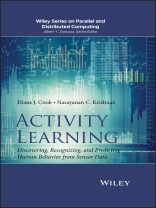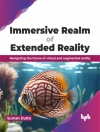Defines the notion of an activity model learned from sensor data and presents key algorithms that form the core of the field
Activity Learning: Discovering, Recognizing and Predicting Human Behavior from Sensor Data provides an in-depth look at computational approaches to activity learning from sensor data. Each chapter is constructed to provide practical, step-by-step information on how to analyze and process sensor data. The book discusses techniques for activity learning that include the following:
- Discovering activity patterns that emerge from behavior-based sensor data
- Recognizing occurrences of predefined or discovered activities in real time
- Predicting the occurrences of activities
The techniques covered can be applied to numerous fields, including security, telecommunications, healthcare, smart grids, and home automation. An online companion site enables readers to experiment with the techniques described in the book, and to adapt or enhance the techniques for their own use.
With an emphasis on computational approaches, Activity Learning: Discovering, Recognizing, and Predicting Human Behavior from Sensor Data provides graduate students and researchers with an algorithmic perspective to activity learning.
قائمة المحتويات
Preface ix
List of Figures xi
1. Introduction 1
2. Activities 5
2.1 Definitions 5
2.2 Classes of Activities 7
2.3 Additional Reading 8
3. Sensing 11
3.1 Sensors Used for Activity Learning 11
3.1.1 Sensors in the Environment 12
3.1.2 Sensors on the Body 15
3.2 Sample Sensor Datasets 17
3.3 Features 17
3.3.1 Sequence Features 21
3.3.2 Discrete Event Features 23
3.3.3 Statistical Features 25
3.3.4 Spectral Features 31
3.3.5 Activity Context Features 34
3.4 Multisensor Fusion 34
3.5 Additional Reading 38
4. Machine Learning 41
4.1 Supervised Learning Framework 41
4.2 Naïve Bayes Classifier 44
4.3 Gaussian Mixture Model 48
4.4 Hidden Markov Model 50
4.5 Decision Tree 54
4.6 Support Vector Machine 56
4.7 Conditional Random Field 62
4.8 Combining Classifier Models 63
4.8.1 Boosting 64
4.8.2 Bagging 65
4.9 Dimensionality Reduction 66
4.10 Additional Reading 72
5. Activity Recognition 75
5.1 Activity Segmentation 76
5.2 Sliding Windows 81
5.2.1 Time Based Windowing 81
5.2.2 Size Based Windowing 82
5.2.3 Weighting Events within a Window 83
5.2.4 Dynamic Window Sizes 87
5.3 Unsupervised Segmentation 88
5.4 Measuring Performance 92
5.4.1 Classifier-Based Activity Recognition Performance Metrics 95
5.4.2 Event-Based Activity Recognition Performance Metrics 99
5.4.3 Experimental Frameworks for Evaluating Activity Recognition 102
5.5 Additional Reading 103
6. Activity Discovery 107
6.1 Zero-Shot Learning 108
6.2 Sequence Mining 110
6.2.1 Frequency-Based Sequence Mining 111
6.2.2 Compression-Based Sequence Mining 112
6.3 Clustering 117
6.4 Topic Models 119
6.5 Measuring Performance 121
6.5.1 Expert Evaluation 121
6.6 Additional Reading 124
7. Activity Prediction 127
7.1 Activity Sequence Prediction 128
7.2 Activity Forecasting 133
7.3 Probabilistic Graph-Based Activity Prediction 137
7.4 Rule-Based Activity Timing Prediction 139
7.5 Measuring Performance 142
7.6 Additional Reading 146
8. Activity Learning in the Wild 149
8.1 Collecting Annotated Sensor Data 149
8.2 Transfer Learning 158
8.2.1 Instance and Label Transfer 162
8.2.2 Feature Transfer with No Co-occurrence Data 166
8.2.3 Informed Feature Transfer with Co-occurrence Data 167
8.2.4 Uninformed Feature Transfer with Co-occurrence Data Using a Teacher–Learner Model 168
8.2.5 Uninformed Feature Transfer with Co-occurrence Data Using Feature Space Alignment 170
8.3 Multi-Label Learning 170
8.3.1 Problem Transformation 173
8.3.2 Label Dependency Exploitation 174
8.3.3 Evaluating the Performance of Multi-Label Learning Algorithms 179
8.4 Activity Learning for Multiple Individuals 180
8.4.1 Learning Group Activities 180
8.4.2 Train on One/Test on Multiple 183
8.4.3 Separating Event Streams 185
8.4.4 Tracking Multiple Users 188
8.5 Additional Reading 190
9. Applications of Activity Learning 195
9.1 Health 195
9.2 Activity-Aware Services 198
9.3 Security and Emergency Management 199
9.4 Activity Reconstruction, Expression and Visualization 201
9.5 Analyzing Human Dynamics 207
9.6 Additional Reading 210
10. The Future of Activity Learning 213
Appendix: Sample Activity Data 217
Bibliography 237
Index 253
عن المؤلف
DIANE J. COOK, Ph D, is a professor in the School of Electrical Engineering and Computer Science at Washington State University, USA. Her research relating to artificial intelligence and data mining have been supported by grants from the National Science Foundation, the National Institutes of Health, NASA, DARPA, USAF, NRL, and DHS. She is the co-author of Mining Graph Data and Smart Environments, both published by Wiley. Dr. Cook is an IEEE fellow and a member of AAAI.
NARAYANAN C. KRISHNAN, Ph D, is a faculty member of the Department of Computer Science and Engineering at the Indian Institute of Technology Ropar, India. His research focuses on activity recognition, pervasive computing, and applied machine learning. Dr. Krishnan received the gold medal for academic excellence in Masters of Technology in Computer Science in 2004 and was nominated for the Best Ph D Thesis Award at Arizona State University in 2010.












